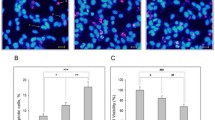Abstract
Humanin (HN), a peptide of 24 amino acid residues, suppresses the neuronal cell death that is induced by the gene products of Alzheimer’s disease. HN contains two Ser residues at positions 7 and 14. Because the proportion of d-Ser isomerized from l-Ser in proteins appears to increase as cellular organs age, we explored the structural effects of the isomerization of each Ser residue in HN. By using a thioflavin-T assay to detect fibril formation, we found that an HN derivative that contained two isomerized d-Ser residues had a greater tendency to form fibrils than did wild-type HN or HNs containing single d-Ser residues. A previous report showed that HN containing two d-Ser residues exerts neuroprotective activity. Our data, therefore, suggest that the fibril formation by HN that contains two d-Ser residues may promote HN neuroprotective activity.



Similar content being viewed by others
References
Arakawa T, Niikura T, Tajima H, Kita Y (2006) The secondary structure analysis of a potent Ser14Gly analog of antiAlzheimer peptide, Humanin, by circular dichroism. J Pept Sci 12(10):639–642
Arisaka F, Niikura T, Arakawa T, Kita Y (2008) The structure analysis of Humanin analog, AGA-(C8R)HNG17, by circular dichroism and sedimentation equilibrium: comparison with the parent molecule. Int J Biol Macromol 43(2):88–93
Benaki D, Zikos C, Evangelou A, Livaniou E, Vlassi M, Mikros E, Pelecanou M (2005) Solution structure of humanin, a peptide against Alzheimer’s disease-related neurotoxicity. Biochem Biophys Res Commun 329(1):152–160
Benaki D, Zikos C, Evangelou A, Livaniou E, Vlassi M, Mikros E, Pelecanou M (2006) Solution structure of Ser14Gly-humanin, a potent rescue factor against neuronal cell death in Alzheimer’s disease. Biochem Biophys Res Commun 349(2):634–642
D’Aniello A, Nardi G, Santis AD, Vetere A, Cosmo AD, Marchelli R, Dossena A, Fisher G (1995) Free l-amino acids and d-aspartate contents in the nerve system of cephalopods. Comp Biochem Physiol 112B:661–660
Fisher GH, Garcia NM, Payan IL, Cadilla-Perezrios R, Sheremata WA, Man EH (1986) d-aspartic acid in purified myelin and myelin basic protein. Biochem Biophys Res Commun 135(2):683–687
Fujii N, Satoh K, Harada K, Ishibashi Y (1994) Simultaneous stereoinversion and isomerization at specific aspartic acid residues in alpha A-crystallin from human lens. J Biochem 116(3):663–669
Fujii N, Harada K, Momose Y, Ishii N, Akaboshi M (1999) d-amino acid formation induced by a chiral field within a human lens protein during aging. Biochem Biophys Res Commun 263(2):322–326
Hashimoto Y, Ito Y, Niikura T, Shao Z, Hata M, Oyama F, Nishimoto I (2001a) Mechanisms of neuroprotection by a novel rescue factor humanin from Swedish mutant amyloid precursor protein. Biochem Biophys Res Commun 283(2):460–468
Hashimoto Y, Niikura T, Ito Y, Sudo H, Hata M, Arakawa E, Abe Y, Kita Y, Nishimoto I (2001b) Detailed characterization of neuroprotection by a rescue factor humanin against various Alzheimer’s disease-relevant insults. J Neurosci 21(23):9235–9245
Hashimoto Y, Niikura T, Tajima H, Yasukawa T, Sudo H, Ito Y, Kita Y, Kawasumi M, Kouyama K, Doyu M, Sobue G, Koide T, Tsuji S, Lang J, Kurokawa K, Nishimoto I (2001c) A rescue factor abolishing neuronal cell death by a wide spectrum of familial Alzheimer’s disease genes and Abeta. Proc Natl Acad Sci USA 98(11):6336–6341
Hashimoto Y, Suzuki H, Aiso S, Niikura T, Nishimoto I, Matsuoka M (2005) Involvement of tyrosine kinases and STAT3 in Humanin-mediated neuroprotection. Life Sci 77(24):3092–3104
Heck SD, Faraci WS, Kelbaugh PR, Saccomano NA, Thadeio PF, Volkmann RA (1996) Posttranslational amino acid epimerization: enzyme-catalyzed isomerization of amino acid residues in peptide chains. Proc Natl Acad Sci USA 93(9):4036–4039
Klunk WE, Pettegrew JW, Abraham DJ (1989) Quantitative evaluation of congo red binding to amyloid-like proteins with a beta-pleated sheet conformation. J Histochem Cytochem 37(8):1273–1281
Naiki H, Higuchi K, Hosokawa M, Takeda T (1989) Fluorometric determination of amyloid fibrils in vitro using the fluorescent dye, thioflavin T1. Anal Biochem 177(2):244–249
Okuma E, Fujita E, Amano H, Noda H, Abe H (1995) Distribution of free d-amino acids in the tissues of crustaceans. Fish Sci 61:157–160
Pistolesi S, Rossini L, Ferro E, Basosi R, Trabalzini L, Pogni R (2009) Humanin structural versatility and interaction with model cerebral cortex membranes. Biochemistry 48(22):5026–5033
Terashita K, Hashimoto Y, Niikura T, Tajima H, Yamagishi Y, Ishizaka M, Kawasumi M, Chiba T, Kanekura K, Yamada M, Nawa M, Kita Y, Aiso S, Nishimoto I (2003) Two serine residues distinctly regulate the rescue function of Humanin, an inhibiting factor of Alzheimer’s disease-related neurotoxicity: functional potentiation by isomerization and dimerization. J Neurochem 85(6):1521–1538
Yang JT, Wu CS, Martinez HM (1986) Calculation of protein conformation from circular dichroism. Methods Enzymol 130:208–269
Acknowledgments
This work was supported by a Japan Society for the Promotion of Science Grant-in-Aid for Scientific Research (C).
Author information
Authors and Affiliations
Corresponding author
Rights and permissions
About this article
Cite this article
Hayashi, K., Sasabe, J., Chiba, T. et al. d-Ser-containing humanin shows promotion of fibril formation. Amino Acids 42, 2293–2297 (2012). https://doi.org/10.1007/s00726-011-0971-6
Received:
Accepted:
Published:
Issue Date:
DOI: https://doi.org/10.1007/s00726-011-0971-6




